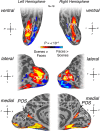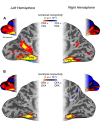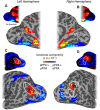Scene-Selectivity and Retinotopy in Medial Parietal Cortex
- PMID: 27588001
- PMCID: PMC4988988
- DOI: 10.3389/fnhum.2016.00412
Scene-Selectivity and Retinotopy in Medial Parietal Cortex
Abstract
Functional imaging studies in human reliably identify a trio of scene-selective regions, one on each of the lateral [occipital place area (OPA)], ventral [parahippocampal place area (PPA)], and medial [retrosplenial complex (RSC)] cortical surfaces. Recently, we demonstrated differential retinotopic biases for the contralateral lower and upper visual fields within OPA and PPA, respectively. Here, using functional magnetic resonance imaging, we combine detailed mapping of both population receptive fields (pRF) and category-selectivity, with independently acquired resting-state functional connectivity analyses, to examine scene and retinotopic processing within medial parietal cortex. We identified a medial scene-selective region, which was contained largely within the posterior and ventral bank of the parieto-occipital sulcus (POS). While this region is typically referred to as RSC, the spatial extent of our scene-selective region typically did not extend into retrosplenial cortex, and thus we adopt the term medial place area (MPA) to refer to this visually defined scene-selective region. Intriguingly MPA co-localized with a region identified solely on the basis of retinotopic sensitivity using pRF analyses. We found that MPA demonstrates a significant contralateral visual field bias, coupled with large pRF sizes. Unlike OPA and PPA, MPA did not show a consistent bias to a single visual quadrant. MPA also co-localized with a region identified by strong differential functional connectivity with PPA and the human face-selective fusiform face area (FFA), commensurate with its functional selectivity. Functional connectivity with OPA was much weaker than with PPA, and similar to that with face-selective occipital face area (OFA), suggesting a closer link with ventral than lateral cortex. Consistent with prior research, we also observed differential functional connectivity in medial parietal cortex for anterior over posterior PPA, as well as a region on the lateral surface, the caudal inferior parietal lobule (cIPL). However, the differential connectivity in medial parietal cortex was found principally anterior of MPA. We suggest that there is posterior-anterior gradient within medial parietal cortex, with posterior regions in the POS showing retinotopically based scene-selectivity and more anterior regions showing connectivity that may be more reflective of abstract, navigationally pertinent and possibly mnemonic representations.
Keywords: memory; population receptive fields; resting-state functional connectivity; retinotopy; scene-selectivity.
Figures












Similar articles
-
Three cortical scene systems and their development.Trends Cogn Sci. 2022 Feb;26(2):117-127. doi: 10.1016/j.tics.2021.11.002. Epub 2021 Nov 29. Trends Cogn Sci. 2022. PMID: 34857468 Free PMC article. Review.
-
A Posterior-Anterior Distinction between Scene Perception and Scene Construction in Human Medial Parietal Cortex.J Neurosci. 2019 Jan 23;39(4):705-717. doi: 10.1523/JNEUROSCI.1219-18.2018. Epub 2018 Nov 30. J Neurosci. 2019. PMID: 30504281 Free PMC article.
-
Evaluating the correspondence between face-, scene-, and object-selectivity and retinotopic organization within lateral occipitotemporal cortex.J Vis. 2016;16(6):14. doi: 10.1167/16.6.14. J Vis. 2016. PMID: 27105060 Free PMC article.
-
A Retinotopic Basis for the Division of High-Level Scene Processing between Lateral and Ventral Human Occipitotemporal Cortex.J Neurosci. 2015 Aug 26;35(34):11921-35. doi: 10.1523/JNEUROSCI.0137-15.2015. J Neurosci. 2015. PMID: 26311774 Free PMC article. Clinical Trial.
-
The pre/parasubiculum: a hippocampal hub for scene-based cognition?Curr Opin Behav Sci. 2017 Oct;17:34-40. doi: 10.1016/j.cobeha.2017.06.001. Curr Opin Behav Sci. 2017. PMID: 29167810 Free PMC article. Review.
Cited by
-
The Neurocognitive Basis of Spatial Reorientation.Curr Biol. 2018 Sep 10;28(17):R1059-R1073. doi: 10.1016/j.cub.2018.04.057. Curr Biol. 2018. PMID: 30205055 Free PMC article. Review.
-
Distributed representations of behavior-derived object dimensions in the human visual system.bioRxiv [Preprint]. 2024 Jul 11:2023.08.23.553812. doi: 10.1101/2023.08.23.553812. bioRxiv. 2024. Update in: Nat Hum Behav. 2024 Nov;8(11):2179-2193. doi: 10.1038/s41562-024-01980-y. PMID: 37662312 Free PMC article. Updated. Preprint.
-
Three cortical scene systems and their development.Trends Cogn Sci. 2022 Feb;26(2):117-127. doi: 10.1016/j.tics.2021.11.002. Epub 2021 Nov 29. Trends Cogn Sci. 2022. PMID: 34857468 Free PMC article. Review.
-
Idiosyncratic patterns of interhemispheric connectivity in the face and scene networks of the human brain.Imaging Neurosci (Camb). 2024 May 20;2:imag-2-00181. doi: 10.1162/imag_a_00181. eCollection 2024. Imaging Neurosci (Camb). 2024. PMID: 40800432 Free PMC article.
-
Two scene navigation systems dissociated by deliberate versus automatic processing.Cortex. 2021 Jul;140:199-209. doi: 10.1016/j.cortex.2021.03.027. Epub 2021 Apr 22. Cortex. 2021. PMID: 33992908 Free PMC article.
References
-
- Brodmann K. (1909). Vergleichende Lokalisationslehre der Groshirnrinde. Leipzig: Barth.
Grants and funding
LinkOut - more resources
Full Text Sources
Other Literature Sources

